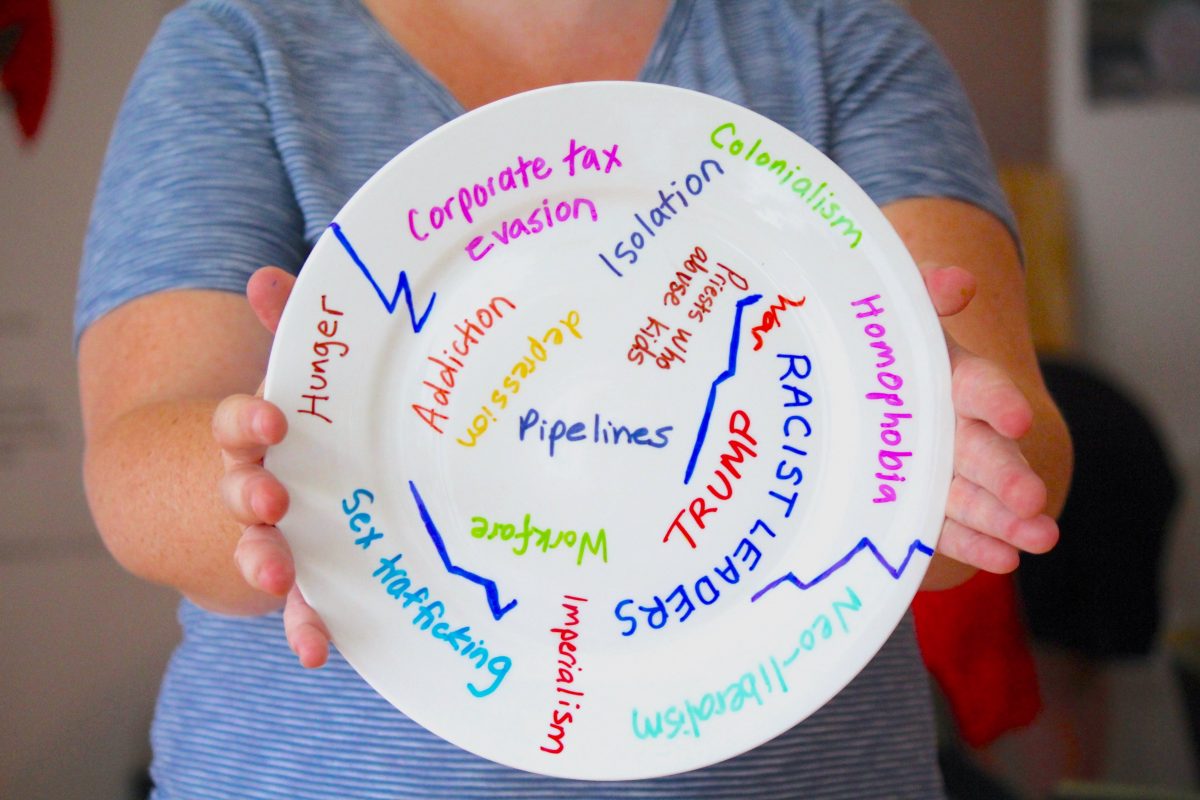How the act of smashing plates can be a transformative experience
“I’ve been thinking about all the things I want to smash all week,” says Marlo Turner, an NDG local, as she enters the gallery space for Smashing the Platriarchy 2.0. Lindsay Fleming and Melanie Stuy, organizers of the participatory performance art event, hand Turner a plate and greet her warmly. Locating her coloured sharpie of choice, Turner eagerly joins the dozen other participants who scribble away their soon-to-be-smashed thoughts.
Smashing the Platriarchy 2.0 took place from Aug. 21 to 23 during the 9th annual NDG Arts Week. The event is a trifecta of interactive exhibits that invites attendees to physically, auditorily and thoughtfully engage with a variety of materials.
Participants express negative feelings that stem from sexism and racism, to xenophobia and climate change on old plates provided by Stuy and Fleming. Afterwards, adorned in safety goggles and with their plates snuggly wrapped in a burlap sack, they smash them with a hammer.
Throughout the three day event, participants use the broken plate shards to fill out a mosaic on a piece of cut wood, creating the beautiful shape of a bird to symbolize freedom, explains Stuy.
I select a plate, a blue sharpie and choose a seat between Fleming’s eldest daughter, Grace, and another attendee, Rayanna Speede, to write down whatever comes to mind. Speede and I begin explaining what our plates are about.
“I’ve been dissecting a lot lately, so I think that’s what came out,” says Speede, in reference to the swirl of mandalas decorating her plate. I ask her what she thinks smashing the plate will feel like, and she responds: “Like closing a chapter. Being introspective is good, and I think smashing this after will be a good thing.”
Stuy and Fleming hope the community art project will start conversations. The pair want to create safe spaces that are conducive to open dialogue and aid in the processing of feelings that are typically repressed or are too large to condense into words, they say.
“The night of and day after the 2016 US election, I wasn’t ready to put my feelings into words,” explains Fleming. “But I had a lot of them, and they were big.”
While chatting with Stuy from the cozy confines of a quaint coffee shop a few days prior to the event, she recalled the post-election days leading up to the creation of Smashing the Platriarchy 2.0. It all started with a group of friends and family coming together over the mutual desire to externalize their feelings.
“I like the idea of art as a transformation,” said Stuy, explaining how the idea of breaking plates with friends evolved into creating a transformative art piece. By assembling the mosaic as a community, piece by piece, Stuy hopes to create beauty from brokenness, and “turn those negative feelings into something more positive.”
Passers-by and attendees who didn’t want to smash plates were encouraged to contribute to the Wall of Ideology, a collection of written thoughts, feelings and phrases on display inside the gallery space. Recordings of people recounting their personal stories from previous gatherings on mp3 players were also available for audiences to listen to.
“I’m learning something new today that I didn’t know anything about!” says Lynne, a participant, after listening to the audio recordings and examining other people’s plates.
Laura Kamugisha, a Concordia student and communications assistant for NDG Arts Week, explains what the paragraph on her plate is about.
“It’s about being used,” she says. “About being the pillar of the home… but not having a seat at the table, even though you built the table.”
Stuy and Fleming believe that showing children how to acknowledge and express their emotions is essential. “It’s important for [kids] to be a part of that conversation too,” explains Stuy. “It gives them an opportunity to channel their feelings, and for their opinions to be heard.”
Grace, at only nine years old, nonchalantly asks her mother what the current gender wage gap is so she can write it on her plate.
“It’s really interesting,” Stuy explains, “because [some] people couldn’t believe, not only that we had smashed plates, but that we let our kids do it too.”
As individuals, it’s important to find and create our own channels for expressing all of the thoughts we may be trying to process but that we can’t necessarily put into words.
Coming together to vocalize, process, and physically break the negative thoughts that would otherwise remain unaddressed is not only empowering, but incredibly healing. Especially when done as a community with one unified goal: to smash the patriarchy.
